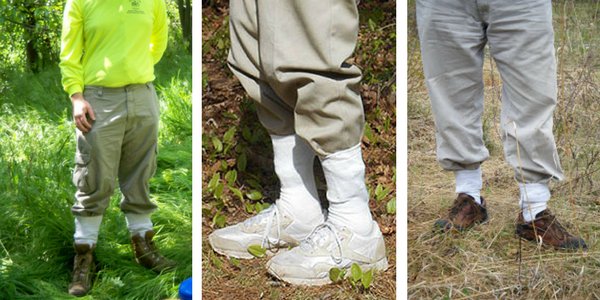Image by Lancaster General Health
We talked to Dan Wolff – The Tick Man and creator of TickEase – to learn more about what makes ticks “tick” and what you should do when you get a tick bite. We want everyone to understand that the best thing you can do to protect yourself is prevention and education, but sometimes, despite your best efforts. It can happen. In this post, you will learn about the following:
- The behavior of deer ticks
- How to prevent tick bites
- What to do if you get a tick bite
DISCLAIMER: We are talking strictly about DEER TICKS in this piece. Those little arachnids hold a lot more danger and behave a lot differently than your average tick.
5 things to know about deer tick behavior:
- They love thick brush → Ticks will wait in thick brush with the front pair of their legs outstretched. Their little paws are sticky like velcro, so they will be ready to latch on.
- They do not like dry low humidity → Deer ticks will tend to stay in the grasses and leave as moisture increases.
- The younger the tick, the lower they will wait → Some of the youngest ticks will be barely off the ground, so it is not just the high brushes you have to worry about.
- The older they are, the higher they will wait → Still worry about the high brush because that is where the more experienced ticks may be waiting for you.
- If you can’t already tell, deer ticks are waiters or “questers”→ It is in their nature to wait for dinner; a deer tick can go up to 8 months without a blood meal!
Follow tick-free fashion guidelines:

- Tuck your pants → Not everyone will understand your fashion statement, but we will! Don’t forget to tuck your pants into your socks.
- Permethrin clothing is the best → Ticks will fall off and die when they come in direct contact with this special fabric coated with this pesticide.
Tips on thorough triple-checking for ticks:
- Get Naked! → Just strip down and give yourself a solid look.
- Check more than once → Deer ticks are so small you may miss one the first time around.
- Don’t neglect your crevices! Make sure to check all your private areas (ticks love them!)
- Don’t be afraid to ask for help → Have someone check for ticks on you. A true friend will look for a tick.
- Take a warm shower and scrub your skin after you’ve finished checking.
What to do if you do get a deer tick bite?
We know how stressful it can be it if you find a tick has bitten you. If you do get a tick-bite, carefully follow the steps below:
- Do not traumatize the tick. → Any poison, suffocation, or heat will traumatize the tick. Like humans, when a tick experiences poison, suffocation, or intense heat, the body will know that death might be coming. The reaction of the tick as it starts to die will be to regurgitate its’ innards back into the host. The innards are where the bacteria for Lyme resides, and you want to avoid that as best you can.
- Do not agitate the tick. → Squeezing the tick will squeeze the innards right back into your body. Flat-tip tweezers cause a bigger risk of squashing the tick, so try to stay away from those when you are extracting.
- Use tweezers that have a very fine tip. → Using a fine tip and lifting straight up will avoid the most damage. TickEase provides that fine point and helps you pull straight up. Once you have the body out, there is no further risk of infection, so don’t worry if you leave the mouthparts behind.
- SAVE YOUR TICKS → If you do get bitten by a tick, get out that plastic bag and carefully place it there. You can send your tick for testing. Go to tickease.com and select “Tick Testing” to find more information on sending your tick in for testing.
- Research → Not only will you know if the tick is infected with Lyme, but it can help those researchers studying the bacteria.
Tick Safety created the following image with clearly illustrates point number 3 above:

Got more questions? Check out our Learning Hubs or leave a comment below.

